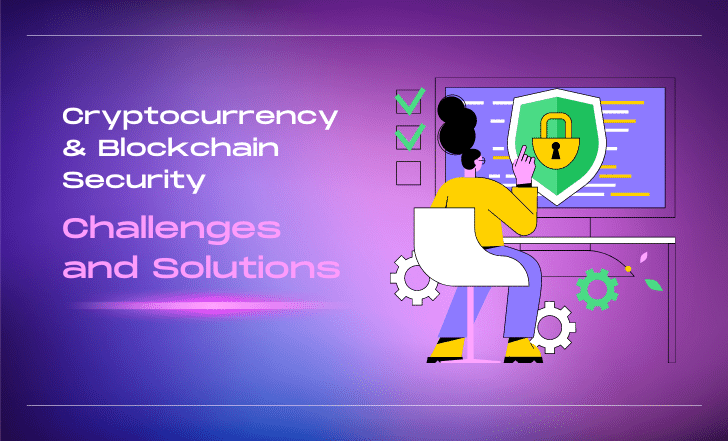If we define cryptocurrency, it is a digital asset used for performing transitions digitally. Strong cryptography is employed in it to safeguard financial transactions, restrict the creation of new units, and confirm the transfer of assets.
Furthermore, the underlying technology that powers cryptocurrency is blockchain. What’s that? Well, Blockchain is a distributed digital ledger that stores transactional records across a network of computers, providing an unchangeable and secure platform.
In essence, it offers an incorruptible way to document and monitor any type of transaction. It does not need a central authority or intermediary.
Consequently, each transaction is verified and recorded by a network of users and, once recorded, cannot be altered or deleted.
Nevertheless, in spite of the myriad advantages associated with cryptocurrencies and blockchain technology, what are the significant security challenges that necessitate attention? Let’s have that discussion into some of the potential cryptocurrency and blockchain security challenges and their corresponding solutions.
But digging into that, we must understand more about blockchain and cryptocurrency.
Blockchain Technology Explained- How Does It Work?
The term “blockchain” originated from its unique method of holding transaction records, with each block linked together to form an unbreachable chain. As the number of transactions increases, the blockchain dynamically expands alongside it.
Each block in this robust system actively records and confirms the precise time and sequence of transactions, all carefully logged within the blockchain.
These operations occur within an exclusive network governed by rules collectively agreed upon by the participating members.
Furthermore, within each block, you see a distinct digital fingerprint or unique identifier known as a hash. Hash plays a pivotal role in maintaining the integrity of the blockchain.
Plus, timestamped batches of recent valid transactions are actively included within the block alongside the crucial hash of the previous block.
The inclusion of the previous block’s hash serves a vital purpose by actively connecting the blocks together, ensuring that no modifications can be made to any block or the insertion of a new block between existing ones.
This method, in theory, establishes an impenetrable barrier, rendering the blockchain impervious to tampering.
Types of Blockchain
1. Public Blockchain
Public blockchain operates as a permissionless distributed ledger, actively welcoming and allowing anyone to join and engage in transactions.
These blockchains facilitate equal rights for all nodes, enabling them to access the blockchain, generate new blocks of data, and validate existing blocks.
The public blockchains primarily serve as platforms for cryptocurrency exchange and mining. Some of the real-time examples of the public blockchain are:
- Bitcoin
- Ethereum
- Bitcoin Cash
- Litecoin
- Monero
- IOTA
2. Private Blockchain
Private blockchains, alternatively known as managed blockchains, incorporate permissioned networks under the control of a single organization.
Within this structure, the central authority determines which entities can participate as nodes within the private blockchain.
Furthermore, the central authority can allocate varying degrees of functionality and rights to different nodes within the network.
Unlike public blockchains, which emphasize inclusivity and transparency, private blockchains are tailor-made to satisfy the requirements and specifications of a specific network or organization.
Some examples of private blockchains are:
- Ethereum Enterprise
- Hyperledger
- Ripple
- R3 Corda
3. Consortium Blockchain
Consortium blockchains aim to strike a balance by allowing a select group of trusted entities to participate in the validation process, enhancing efficiency while maintaining a degree of decentralization.
4. Hybrid Blockchain
On the other hand, hybrid blockchains combine elements of both private and public blockchains, tailoring the network structure best to suit the specific requirements and objectives of the participants.
These advancements in blockchain technology offer alternative approaches to overcome the limitations associated with private and public blockchains.
5 Cryptocurrency And Blockchain Security Issues And Solutions
Cryptocurrency and blockchain technology have ushered in a revolutionary era of digital transactions, yet the soaring prevalence of these transactions has concurrently amplified security concerns.
Here are 5 of the blockchain security challenges and their solutions.
1. 51% Attack
One of the cryptocurrency and blockchain challenges is a “51% Attack.” With a majority attack, sometimes called a 51% attack, an entity can take control of more than half of a blockchain’s computational power. This dominance is typically achieved by renting mining hash power from a third party.
Upon successfully executing a 51% attack, the perpetrators acquire the ability to alter the confirmation of new transactions and manipulate the order in which these transactions are processed.
Hackers can rewrite segments of the blockchain, including reversing their own transactions, thus creating a phenomenon known as double-spending.
Furthermore, a 51% attack is one of the most dreaded threats in the realm of blockchain. Usually, at its outset, a blockchain is especially vulnerable to attacks.
Also, one remarkable thing is that it does not applicable to enterprise or private blockchains, which possess different mechanisms and security measures to safeguard against such risks.
In recent years, 51% attacks have emerged, causing significant disruptions in the cryptocurrency landscape.
- One such incident occurred in August 2021 when Bitcoin SV (BSV) experienced a decline of approximately 5% in value following an attack.
- Bitcoin Gold (BTG), another fork of Bitcoin, also fell victim to a 51% attack in 2019.
Solutions to the problem of a 51% Attack:
- Implementing Proof-of-Stake (PoS) consensus reduces 51% of attack risks by relying on token ownership instead of computational power. This economically deters attackers from controlling network resources.
- Preventing 51% of attacks involves increasing the network’s hash rate. This decentralizes the network, making it difficult for any individual or group to gain control.
- Effective governance and attentive monitoring ensure blockchain security. Regular audits, bug bounties, and community involvement build trust and support network growth.
2. Phishing Attacks
Phishing is a widespread cyberattack that targets individuals and has also extended into the cryptocurrency domain. In attacks, scammers pose as trustworthy entities to trick victims into revealing sensitive information, like their wallet’s private key.
By doing so, they can access the victim’s digital assets and steal them. Usually, scammers try to contact cryptocurrency holders through SMS, phone calls, and emails. There is a fake link to a reputable company in the mail.
When a victim clicks the link and enters their private key or other information, it is sent straight to the scammers.
Through crypto phishing, scammers easily breach crypto wallets and effortlessly transfer funds to different addresses.
Almost twice as much crypto was stolen in 2021 as in 2020, when scammers stole $14 billion. Some standard crypto and blockchain phishing scams that have surfaced recently are:
- Malicious AirDrops
- Seed Phrase Phishing
- Ice Phishing
- Clone Phishing Attack
Solutions to the problem of phishing attacks:
- To strengthen device security, install a dependable anti-virus program as well as malicious link detection software.
- To boost browser security, add a verified extension to alert you about dangerous sites.
- Prior to clicking any links, be sure to scrutinize them. If you receive an email asking for login information in relation to the matter, be sure to check with the partner.
- Instead of clicking the link, manually enter the address in your browser.
- Ensure your system and programs are up to date.
3. Blockchain Endpoint Vulnerabilities
The vulnerability of blockchain endpoints represents an ongoing security challenge within the blockchain ecosystem.
The endpoint of a blockchain network refers to the point at which users directly engage with the blockchain using electronic devices, i.e. mobile phones, tablets, and computers.
Hackers can closely monitor user behavior, seeking opportunities to target these devices to steal the user’s key. By gaining unauthorized access to the key, they can compromise the user’s security and potentially gain control over their blockchain assets or sensitive information.
This particular blockchain security challenge highlights the importance of implementing robust measures to protect blockchain endpoints.
Solutions to the problem of blockchain endpoint vulnerabilities:
- Implement robust authentication methods, encryption protocols, and regular security updates to mitigate the risk of endpoint vulnerabilities.
- Install reputable antivirus software on your electronic devices.
- Avoid storing blockchain keys as text files on your computer or mobile phone.
- Regularly review your system, monitoring time, location, and device access.
- By adopting stringent security practices, blockchain users can enhance the overall security posture of the ecosystem and minimize the potential for unauthorized access and data breaches.
4. Sybil Attacks
The Sybil attack represents a sophisticated strategy adversaries employ to manipulate blockchain networks. This attack is orchestrated by assigning multiple identifiers to a single node, taking advantage of the decentralized nature of blockchain networks where trust is not centralized, and requests are distributed among various nodes.
During a Sybil attack, a hacker gains control over numerous nodes within the network. These malicious nodes form a virtual barrier around the victim, surrounding them with fraudulent nodes that collude to intercept and manipulate their transactions. Consequently, the victim becomes vulnerable to double-spending attacks, undermining the integrity of the blockchain.
In the space of peer-to-peer networks, one notable instance of a Sybil attack occurred in 2014 against the Tor network. Tor, a decentralized network facilitating private conversations, fell victim to this attack.
A similar, but potentially more damaging, Sybil attack targeted Bitcoin holders utilizing the Tor network in 2020. The hackers behind this attack specifically targeted individuals conducting Bitcoin transactions through Tor.
Solutions to the problem of Sybil Attacks:
- One approach is to increase the cost associated with creating new identities, making it economically unfeasible for attackers to amass a significant number of fake nodes.
- Another strategy involves implementing trust-based mechanisms for joining the network, requiring some form of authentication or verification before allowing participation.
5. Routing attacks
Routing attacks present a substantial security and privacy risk within the realm of blockchain technology, necessitating increased vigilance and proactive measures.
The seamless functioning of blockchain technology heavily relies on resilient network infrastructure. However, vulnerabilities inherent in the Border Gateway Protocol (BGP), the routing protocol employed by internet service providers (ISPs) to exchange route information, can be exploited by malicious actors.
Security issues associated with routing in blockchain networks can yield severe consequences. An illustrative example is the 2014 incident wherein a hacker successfully executed a routing attack, impeding the propagation of mined blocks across the network.
By deceitfully claiming ownership of the work conducted by legitimate miners, the attacker wrongfully acquired mining fees, compromising the fairness and integrity of the blockchain ecosystem.
Solutions to the problem of routing attacks:
- Enhancing the security and resilience of the underlying network infrastructure, ensuring that ISPs employ secure routing protocols and diligently address vulnerabilities in the BGP.
- Blockchain networks should implement mechanisms to detect and mitigate routing attacks, such as monitoring for anomalies and unauthorized route changes.
Winding Up!
As the value of your blockchain increases in the marketplace, it becomes more susceptible to attacks. This blog has provided insights into some of the common cryptocurrency and blockchain challenges and solutions to overcome them.
Blockchain is considered a groundbreaking technology that combines robust coding practices with consensus-building processes. The security of a blockchain relies on the underlying programming.
When building a blockchain, it is crucial to ensure that all possible loopholes are identified and effectively blocked.
Hire a team of highly experienced blockchain developers who specialize in ensuring the security of blockchain systems.
Experienced professionals are adept at mitigating the security issues associated with blockchain technology.
However, while the services of a blockchain development company may seem costly, it will be worth the investment.
Featured Image Credit: Graphic provided by the Author; Thank you!


















